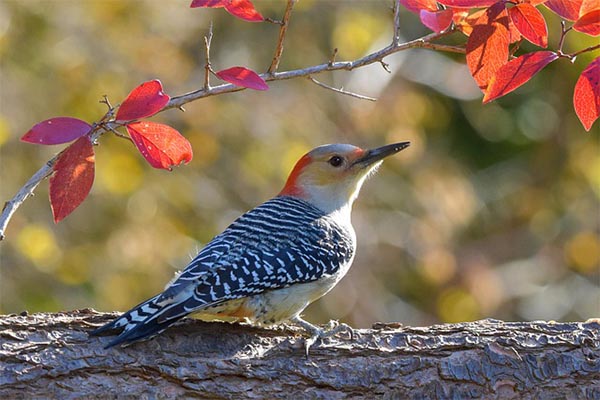
photo credit: JackBulmer on Pixabay
The Red-bellied Woodpecker is known as the most conspicuous species of woodpecker in San Angelo, Texas. The name “red-bellied” resembles the color of their belly part. However, it is not well-appreciated as the pale-red patch on their belly is very small and unnoticeable.
This species is known for its black and white zebra-patterned back and red stripe on the top of the head and locally well-known and bred in Texas, United States.
In this article, we are going to cover a wide variety of topics related to the Red-Bellied Woodpecker, such as:
- How to identify them
- How, when, and where they migrate
- Their diet
- How and where they nest
- And much more…
So, without any more delay…
Let’s jump right into it and learn more about the Red-Bellied Woodpecker.
Red-bellied Woodpecker Facts
- Common Name: Red-bellied Woodpecker
- Scientific Name: Melanerpes carolinus
- Scientific Family: Picidae
- Life Span: 12 years
- Size: 9.4 inches
- Wingspan: 13.0 to 16.5 inches
- Weight: 2.0 to 3.2 oz
- Conservation status: Least concern
How To Identify A Red-bellied Woodpecker
Red-bellied Woodpeckers are medium-sized birds with a sleek and round head. They generally have a pale color overall. Their faces and cheeks are white, and you’ll notice a red color on top and at the back of their heads.
The back, wing, and tail areas have a striking black and white striped color. And finally, as their name implies, there’s a patch of reddish color on their bellies.
Unfortunately, this can be invisible when looking from a different angle due to the feathers, making the identification process would be a bit challenging.
Differences Between Male & Female
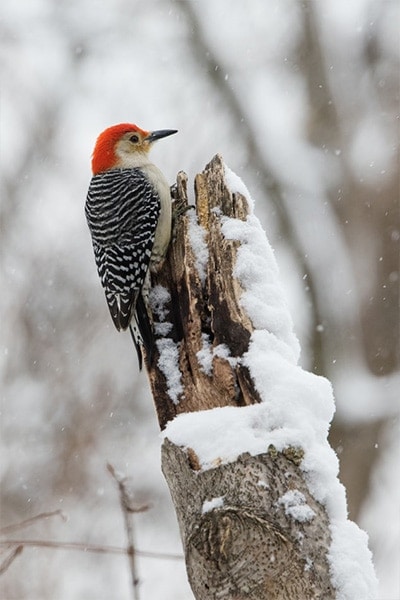
photo credit: Mark Olsen on Unsplash
Male and female Red-bellied Woodpeckers generally look the same. However, it has been noted that the male birds tend to be larger, and the red cap extends from their bills down to their napes.
On the other hand, females will be seen with a red spot above the bill, a red patch on their nape, and a gray crown.
Differences In Summer Plumage vs Winter Plumage
Red-bellied Woodpeckers look the same all-year-round, regardless if it’s the winter or the summer season.
Red-bellied Woodpecker Sounds
Where You’ll See Red-bellied Woodpeckers
Red-bellied Woodpeckers can only be found in the eastern half of the United States. The range starts in Minnesota, going down to Louisiana to Florida and further extending eastward to New York.
These birds are often seen in various habitats such as wetlands, woodlands, and tree trunks. They are most common in low elevations of below 2000 feet.
Red-bellied Woodpecker Migration Patterns
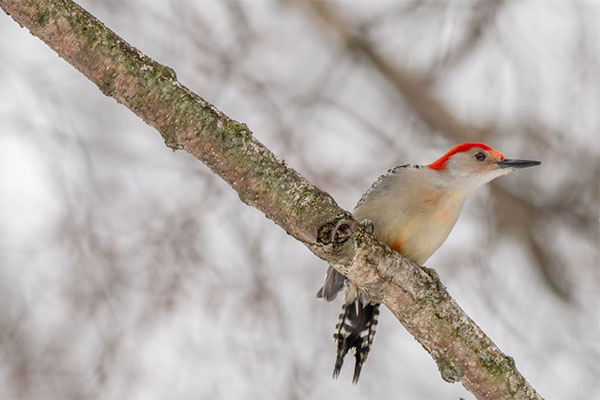
photo credit: Patrice Bouchard on Unsplash
Red-bellied Woodpeckers are considered non-migratory birds. This means that they only stay in the same place the whole-year-round. However, some birds in the northernmost part may move south for winter but remain within their range. Local movements are frequent and are most likely influenced by food supply.
Diet and Feeding Preferences
Red-bellied Woodpeckers can eat both plant and animal materials. However, the majority of their diet consists of insects. This usually includes beetles, grasshoppers, ants, and other insects. They also eat corn, fruits, and beechnuts.
These birds eat depending on what’s abundant during the season. So throughout the winter, their diet mostly consists of seeds and fruits. They can also be found often in areas of bird feeders to probe for food.
Nesting Data
- Clutch Size: 2 to 6 eggs
- # of Broods: 1 to 3 broods
- Incubation Period: 12 days
- Nestling Period: 24 to 27 days
- Egg Description: Smooth white
Nesting
The breeding season for Red-bellied Woodpecker begins in early winter and late spring in March and April. Both males and females will choose a nest site together.
They search and explore the potential nest sites and communicate by tapping each other. Then, they would dig up a nesting area in dead trees or the dead limbs of live trees. There are no additional materials placed inside, other than wood chips that would serve as the bedding for the eggs.
Red-bellied Woodpecker Behavior
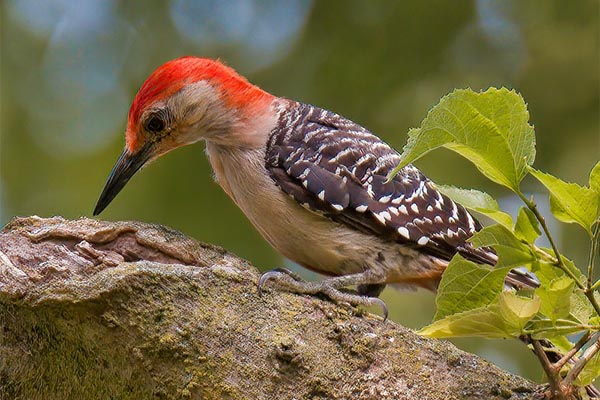
photo credit: Robert Woeger on Unsplash
Red-bellied woodpeckers roam around by walking, hopping, and climbing up the tree trunks. They communicate using non-vocal sounds such as drumming and body signals. The birds’ main communication is through drumming, either in natural or artificial structures like dead trees, stubs, and utility poles.
Furthermore, they love to play when they feel safe in certain areas by flying and sneaking among trees as if they were trying to escape from a predator. When they notice predators are nearby, they usually make warning calls and sounds then fly to shelter in other nearby trees.
Tips for Birdwatchers On How To Attract Red-bellied Woodpeckers
You need to be in the eastern United States if you want to attract Red-Bellied Woodpeckers. So, if you already have a place there, you’ll be happy to know that attracting these beautiful birds can be easy.
These birds love to eat sunflower seeds, suet, and peanuts. So, hang some feeders that are filled with these foods. You can use a suet feeder, a hopper feeder, or a peanut feeder. Make your yard insect-friendly, too, especially in summer, to provide more food for them. If there are dead trees, don’t cut them as they can be perfect nesting sites for these birds.
If you’re planning to drive to the eastern US to find these birds, you simply need to bring foods that will attract them. You should also note that these birds love staying in open woodlands, so make sure to visit those areas.
Threats To The Red-bellied Woodpecker
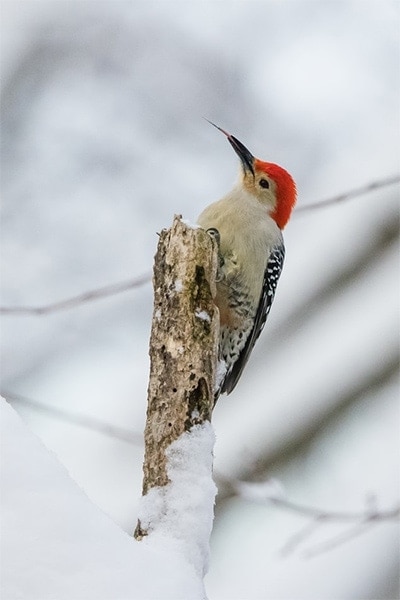
photo credit: Mark Olsen on Unsplash
The Red-bellied Woodpecker’s population continuously increases as the years pass. It has been said that the birds’ ability to adapt to different environments played a significant role in this.
Predators remain to be a threat but don’t cause a significant decline in their numbers. Some known predators of these birds are hawks, snakes, starlings, cats, snakes, and even fellow Woodpeckers.
Fun & Interesting Facts
- Red-bellied Woodpeckers can stick out their tongue 2 inches past the end of their beak.
- Despite their name, it’s difficult to spot the red color on their bellies.
- They love to hear resonate sounds in the surroundings.
- Red-bellied woodpeckers have their uniqueness, unlike other birds, as they have two toes forward and two toes back.
- The oldest recorded Red-Bellied Woodpecker was 12 years and three months old.
Explore More Species in This Family
- Williamson’s Sapsucker
- Yellow-bellied Sapsucker
- Red-naped Sapsucker
- Red-breasted Sapsucker
- Lewis’s Woodpecker
- Red-headed Woodpecker
- Acorn Woodpecker
- Gila Woodpecker
- Golden-fronted Woodpecker
- American Three-toed Woodpecker
- Black-backed Woodpecker
- Downy Woodpecker
- Nuttall’s Woodpecker
- Ladder-backed Woodpecker
- Red-cockaded Woodpecker
- Hairy Woodpecker
- White-headed Woodpecker
- Arizona Woodpecker
- Ivory-billed Woodpecker
- Pileated Woodpecker
- Northern Flicker
- Gilded Flicker
The post Red-bellied Woodpecker: Bird Identification, Habits, Facts, Nesting appeared first on BirdInformer.com.
from BirdInformer.com https://ift.tt/3vQ4TQr

No comments:
Post a Comment